Content
- 1 Self-pollinating varieties of cucumbers for greenhouses
- 2 Self-pollinated varieties of cucumbers for open ground
- 3 Universal self-pollinated cucumber varieties
- 4 Self-pollinated cucumber varieties
- 5 Bee-pollinated cucumber varieties
- 6 Varieties of cucumbers by type of reproduction
- 7 Pollination of cucumbers in the greenhouse
- 8 Parthenocarpic varieties
- 9 Another option for articles on the topic
Read the content of the article!
- Bee-pollinated summer cucumber hybrids with a bundle arrangement of ovaries in the nodes: F1 ABC, F1 True friends, F1 Acorn, F1 Captain, F1 Compass, F1 Teremok, F1 Saltan.
- F1 ABC
- F1 True friends
- F1 Acorn
- F1 Teremok
- Bee-pollinated summer hybrids with simultaneous filling of a large amount of zelents on the plant: F1 Farmer, F1 Lord, F1 Maisky.
- F1 Farmer
- F1 Lord
- Famous delicious shade-tolerant salad hybrids of the winter-spring ecotype of the Relay type: F1 Relay, F1 Olympics, F1 Manul, F1 Marathon, F1 Ladoga, F1 Northern Lights.
- F1 Relay
- F1 Olympics
- F1 Ladoga
- F1 Northern Lights
- Cucumber plants can form 3 types of flowers: female flowers, male flowers, and hermaphrodite flowers.
- Cucumber flower structure
- Pollination of cucumbers
- How to get a large harvest of bee-pollinated cucumbers
Bee-pollinated cucumbers: photos, descriptions, varieties and hybrids. Bee pollinated and parthenocarpic cucumbers are not competitors; they complement each other. At the same time, despite the fact that a pollination process is needed for the formation of greens in bee-pollinated forms, bee-pollinated cucumbers have a number of advantages. Firstly, the greens of bee-pollinated hybrids are more useful, as they have an increased content of biologically active substances, vitamins and carbohydrates due to the seeds being formed. Secondly, it is the bee-pollinated cucumber hybrids that provide the highest quality raw materials for traditional pickling, to obtain the popular classic Russian pickled cucumber. Moreover, unique samples have been created that combine the taste of old varieties with complex disease resistance, cold resistance, shade tolerance, super-beaminess and many other valuable traits.
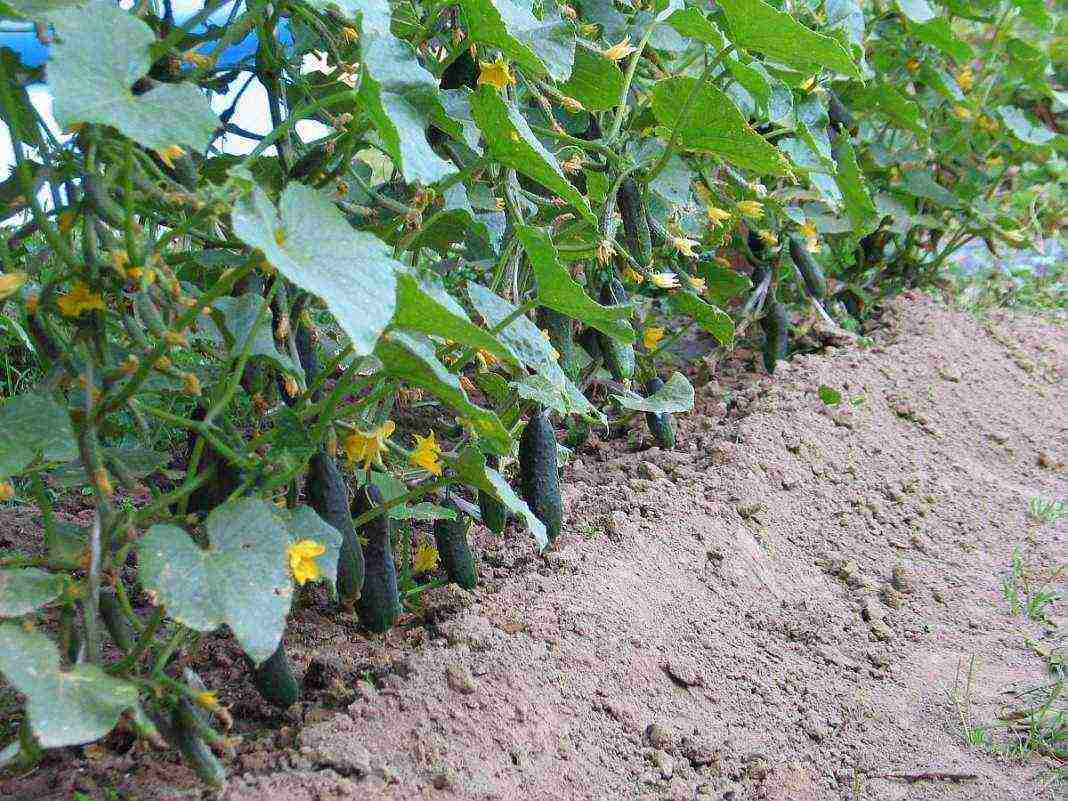
Modern bee-pollinated summer hybrids of the selection of the agricultural firm "Manul" - the female type of flowering (such hybrids are the most productive); for high-quality pollination, 10-15% of the pollinator is sown to them. For this purpose, the selection and seed-growing company "Manul" has created special hybrids-pollinators: white-thornF1 Nectar and blackthornF1 Bumblebeecharacterized by a long flowering period with male flowers. Cucumber hybridsF1 Nectar andF1 Bumblebee not only provide high-quality pollination of plants with a large number of female flowers, but they themselves yield cucumbers with high salting qualities. Pollinating hybridsF1 Nectar andF1 Bumblebee contributed to an increase in the yield of bee-pollinated cucumbers and a renewed interest in them.
Bee-pollinated cucumbers can be divided into 3 groups according to the complex of biological and economic characteristics.
Bee-pollinated summer cucumber hybrids with a bundle arrangement of ovaries in the nodes: F1 ABC, F1 True friends, F1 Acorn, F1 Captain, F1 Compass, F1 Teremok, F1 Saltan.
This group includes bee-pollinated bundle gherkins of the female flowering type with high salting qualities. Plants are vigorous, branching from weak (F1 True friends) to active (F1 Saltan - a hybrid with partial manifestation of parthenocarp).
Summer bee-pollinated beam hybrids differ from others by the abundance of ovaries, their large size, which allows collecting non-pollinated ovaries as mini-picks for canning in small jars. In each node, from 2-3 to 6-8-12 ovaries are formed. Zelentsy are 8-12 cm long, large tubercles, black or white spines, the frequency of tubercles is average ("Russian type of pubescence").F1 Captain andF1 Acorn have a new valuable feature - a delayed filling of fruits, preventing their outgrowth at rare harvests.This feature is important for the canning industry, as well as for gardeners who come to garden plots only on weekends. These are high-tech hybrids created for classic pickling (standard greens) and canning (standard and pickle greens).
F1 ABC
Bee-pollinated early ripening bunch gherkin hybrid of female flowering type for open and protected ground. It begins bearing fruit on the 39-42 day from germination. Branching is average or below average. In the nodes, from 2-4 to 6-10 ovaries are formed. Zelentsy tuberous (the frequency of the location of the tubercles is average), black-spiky, oval-cylindrical, 8-11 cm long, 3.0-3.5 cm in diameter, weighing 90-115 g. Salted and taste qualities are very high. Created for barrel pickling, as well as for canning mini cucumbers in jars. Resistant to olive spot, cucumber mosaic virus, powdery mildew, tolerant to downy mildew. The hybrid is sown with 10-15% of the pollinator. Planting density in open ground 3-5 plants / m2, in greenhouses 2.5-3 plants / m2.
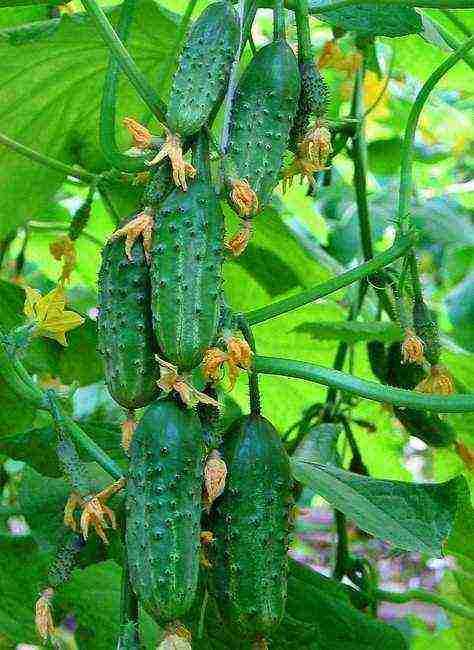
F1 True friends
A popular, very early maturing bee-pollinated bunch gherkin hybrid of the female type of flowering for open ground, tunnels, spring greenhouses. It begins to bear fruit on the 37-39th day from germination. In the nodes, from 2-3 to 5-8 or more ovaries are formed. Cold resistant. Branching is weak, which makes it much easier to care for plants. It is characterized by abundant fruiting in all growing conditions. Zelentsy are lumpy, black-spiked, oval-cylindrical, 8-10 cm long. Salting and taste qualities are very high. Cold hardy, resistant to olive spot, cucumber mosaic virus, tolerant to powdery mildew and downy mildew.
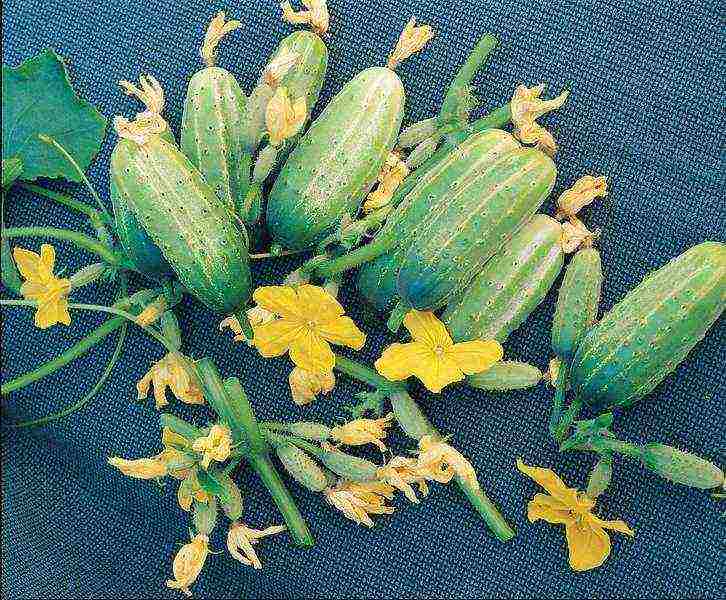
F1 Acorn
Yielding bee-pollinated beam hybrid of gherkin type for open and protected ground. It was named so for the dense crispy greens of high salting qualities. Plants of the female flowering type, branching is limited (lateral shoots are short, determinant type). In the nodes, from 2-3 to 10-12 ovaries are formed.F1 Acorn - a hybrid with slow growth of fruits, which, because of this, do not outgrow poorly with rare harvests. Created for barrel pickling, as well as for canning mini cucumbers in jars. Zelentsy are large tuberous, white-spiked, intense green in color, 8-11 cm long; the frequency of the location of the tubercles is average. Resistant to olive spot, cucumber mosaic virus, tolerant to powdery mildew, downy mildew.
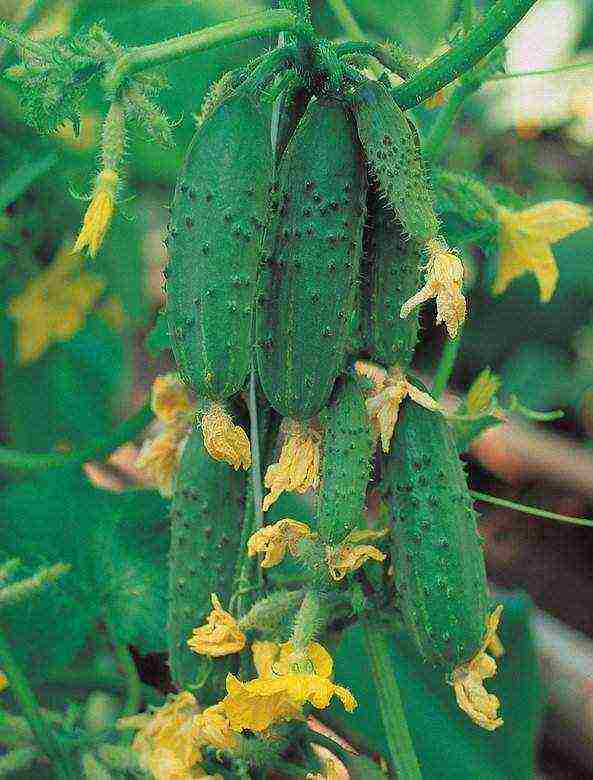
F1 Teremok
High-yielding bee-pollinated beam hybrid of gherkin type for open and protected ground. Plants of the female flowering type, branching is average or below average. Zelentsy are lumpy, black-spiky, 8-12 cm long, of very high salting and taste qualities. In the nodes, from 3-4 to 6-9 ovaries are formed. Created for barrel pickling, as well as for canning mini cucumbers in jars. Resistant to olive spot, cucumber mosaic virus, powdery mildew, tolerant to downy mildew.

Bee-pollinated summer hybrids with simultaneous filling of a large amount of zelents on the plant: F1 Farmer, F1 Lord, F1 Maisky.
These are classic bee-pollinated hybrids for open and protected ground. Thanks to the powerful root system, cold resistance, good regrowth of lateral shoots, they actively bear fruit until late autumn. Zelentsy have high salting and taste qualities. These are hybrids of the female or predominantly female type of flowering, therefore 10-15% of the pollinator is added to them.
F1 Farmer
Classic bee-pollinated hybrid of female or predominantly female flowering type. Designed for open ground, spring greenhouses, tunnels. Branching is average or above average. 1-2 ovaries are formed in the nodes.Zelentsy are large tuberous, white-spiked, 10-12 cm long, dense, crispy; pickling and canning qualities are very high. Intensive plant growth, a powerful root system, active regrowth of lateral shoots, combined with cold resistance and complex disease resistance, lead to long-term friendly fruiting until autumn frosts. The hybrid is resistant to powdery mildew, olive spot, common cucumber mosaic virus, tolerant to downy mildew.
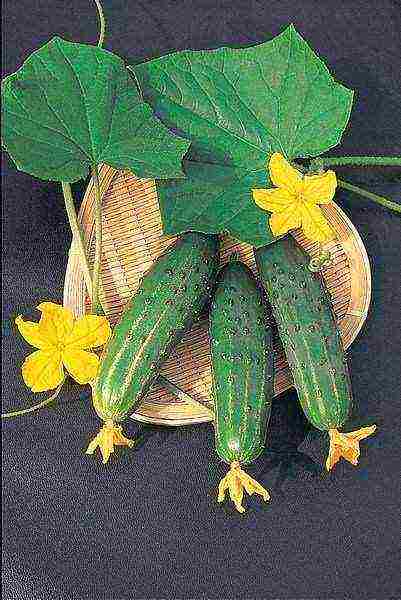
F1 Lord
Yielding mid-season classic bee-pollinated hybrid of predominantly female or female flowering type. It is widely grown in the spring-summer turnover in open and protected ground. Branching is average or above average. A characteristic feature of the hybrid is the intensive growth of the main lash and the rapid appearance of lateral shoots, with the growth of which the peak of mass prolonged fruiting occurs. Cold resistance and resistance of plants to phyto-diseases contribute to high yields even at the end of August - September - in uncomfortable conditions for many varieties. 1-2 ovaries are formed in the nodes. Zelentsy of beautiful bright green color, large tuberous white-spiked, 10-12 cm long; pickling, canning and taste qualities are very high. The hybrid is resistant to powdery mildew, olive spot, common cucumber mosaic virus, tolerant to downy mildew.

Famous delicious shade-tolerant salad hybrids of the winter-spring ecotype of the Relay type: F1 Relay, F1 Olympics, F1 Manul, F1 Marathon, F1 Ladoga, F1 Northern Lights.
These are cucumbers with an inimitable taste and aroma that have no analogues in the world. Hybrids are the classic standard of Russian salad cucumber. The length of the greenery is 15-22 cm, the surface is large-lumpy, glossy or semi-gloss, the frequency of the location of the tubercles is average, the skin is thin (salad type), the flesh is crispy, aromatic. The plants are vigorous, vigorous, shade-tolerant, with strong branching, in summer they actively bear fruit both in greenhouses and in the open field. For high-quality pollination, 10% of the pollinator (F1 Nectar, F1 Bumblebee) is sown to the hybrids. In recent years, F1 Relay, F1 Olympics, F1 Manul have gained great popularity among gardeners and farmers.
Despite the fact that at the beginning of flowering, the plants of the Relay variety hybrids may have a fairly large number of male flowers, they may not be enough to ensure long-term pollination. Male flowers are formed mainly on the main stem, and by the time of mass flowering of lateral shoots of the middle and upper tiers of the plant, they become “female”. If during the period of growing seedlings or after planting it was cool weather, in plants the severity of the female sex increases. Therefore, it is advisable to plant a pollinator for such hybrids.
F1 Relay
Yielding mid-season bee-pollinated hybrid of predominantly female flowering type. Strong branching in summer. Zelentsy 15-20 cm long, lumpy, white-spiked, very tasty. Possesses increased shade tolerance, high plasticity to environmental factors. The hybrid is resistant to the common cucumber mosaic virus, relatively - to root rot.
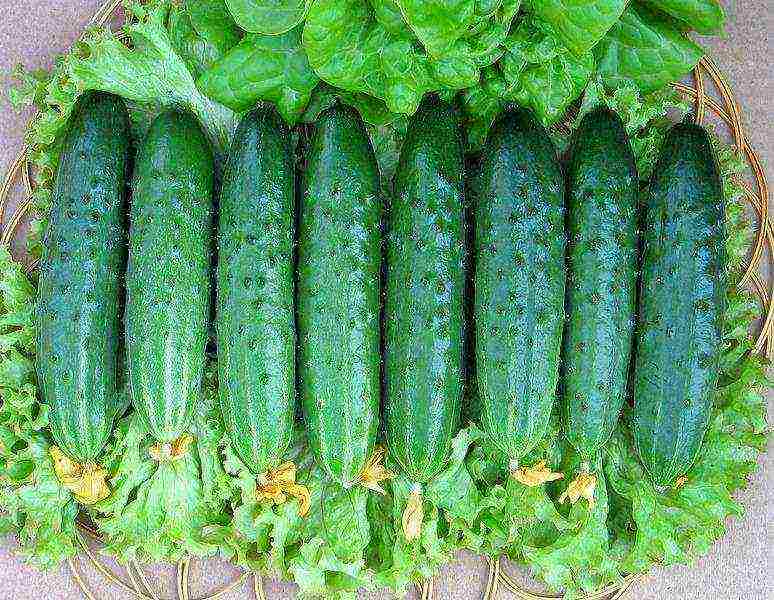
F1 Olympics
A productive, tall mid-season hybrid of an intensive development type with strong branching. Zelentsy lumpy white-thorny, with an inimitable taste and aroma, 16-19 cm long; pubescence is medium, tubercles are large.F1 Olympics possesses high ecological plasticity, has resistance to common cucumber mosaic virus, tolerance to root rot.
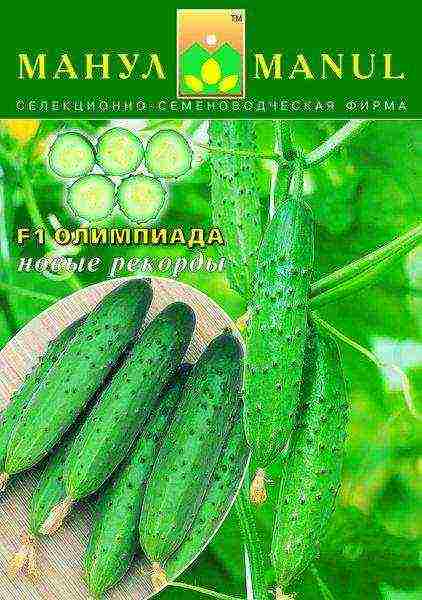
F1 Ladoga
Yielding mid-season bee-pollinated hybrid of predominantly female flowering type. It is characterized by intensive growth and high productivity potential. Zelentsy lumpy white-spiked, 16-18 cm long, bright green color with longitudinal light stripes, inimitable taste and aroma.The tubercles are large, the frequency of the tubercles is average. Moderate to strong branching. Hybrid with a wide optimum temperature range, resistant to olive spot and cucumber mosaic virus.
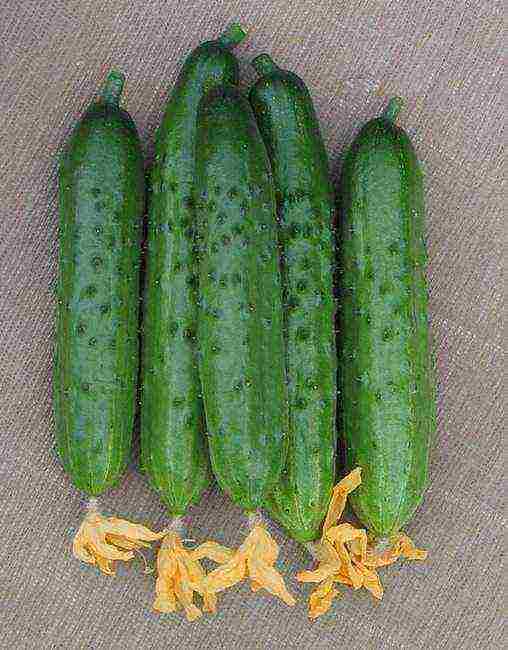
F1 Northern Lights
A yielding bee-pollinated hybrid with very tasty greens. The plants are vigorous, with good branching. Zelentsy are tuberous, white-spined, 16-19 cm long. The tubercles are large, the frequency of the tubercles is rare. Fruits are bright green in color with light longitudinal stripes. A hybrid with a wide optimum temperature range, resistant to olive spot, cucumber mosaic virus.
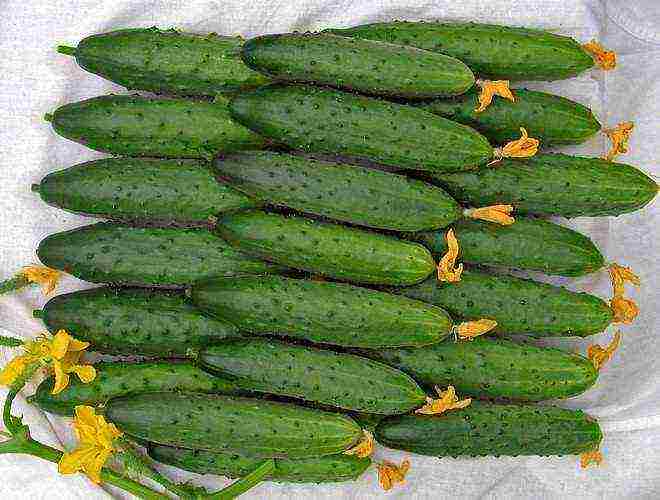
Cucumber plants can form 3 types of flowers: female flowers, male flowers, and hermaphrodite flowers.
Female flowers - always with an ovary (small cucumber), so they can be distinguished from male flowers even before flowering. In parthenocarpic forms, the ovary grows into green plants without pollination (i.e., no bees and other insects or artificial pollination are needed to obtain a crop). In bee-pollinated cucumbers, for the growth of the ovaries (and, therefore, the formation of fruits), pollination of the female flowers with the pollen of the male flowers is necessary. The number of female flowers in a node can be 1, 2 (in long-fruited hybrids) and more - up to 10-12 (in bunch cucumbers).
Male flowers - without ovary, outwardly they are yellow flowers on thin pedicels. The biological meaning of male flowers is pollination of female flowers (both bee-pollinated and parthenocarpic genotypes) in order to obtain seeds. In parthenocarpic forms, greens are formed without pollination, but they do not contain seeds; to obtain seeds in parthenocarpic fruits, the female flowers must be pollinated.
Male flowers are formed at the nodes of the main stem and lateral shoots, as a rule, in bunches - several pieces each.
The pollen of male flowers is sticky, heavy, does not spill out, i.e. wind pollination does not occur in cucumbers, but is carried out only by insects.
Cucumber flower structure
Male flowers consist of a calyx, corolla petals, stamens. There are five stamens, each of them ends with a pollen sac - an anther, which contains pollen grains (pollen).
In female flowers, instead of stamens, there is a pistil, consisting of a stigma, a column and an ovary. The ovary is inferior, usually three-celled, with several rows of ovules in each nest.
Pollination of cucumbers
The pollen of cucumbers germinates on the stigma of the pistil of a female flower at once, and in the form of pollen tubes penetrates through the column of the pistil into the ovules containing eggs. After oocyte pollination, ovaries actively grow in bee-pollinated cucumbers. In parthenocarpic cucumbers, the ovaries grow without pollination.
Male and female cucumber flowers open early in the morning when the sun rises in good weather. If the day before it was cool (about + 15 ... + 17 ° C) and cloudy, the flowers do not open well and may be half-open.
In male flowers, pollen matures 1-2 days before their disclosure. The anthers open on the day of flowering, but if the air temperature is below + 16 ... + 17 ° C, the anthers can open only the next day (and, therefore, on the day of the opening of the male flower, pollination with pollen will not occur).
Pollen has the greatest viability from the moment the flowers open until 11-12 o'clock in the afternoon, then the viability of the pollen decreases, and by the next morning it can be completely lost. The optimum air temperature for pollen is + 20 ... + 30 ° С. At low (+ 14 ... + 16 ° C) and high (above + 40 ° C) air temperatures, the percentage of pollen viability is greatly reduced.
The male flowers themselves persist for 1-2 days, after which they wither.
The flowering of female flowers lasts an average of 2 days. If they are not pollinated, they retain their fresh appearance for several days, while the color of the flowers becomes less bright.The pollination process involves mainly freshly blossoming female and male flowers. They can be distinguished from other flowers that have blossomed a day or more earlier by the bright yellow color of the corolla petals. A certain (small) amount of fruit is also formed when female flowers are pollinated the next day after their opening.
How to get a large harvest of bee-pollinated cucumbers
If the bee-pollinated hybrid is a female type of flowering (i.e., the plants have only female flowers), or a predominantly female type of flowering (there are mainly female flowers on the plants, there are few male flowers), to get a harvest, 10-15% of the pollinator must be planted with it (for 9-10 plants of the main hybrid 1 pollinator plant). Pollinators are varieties or hybrids of the male flowering type; they form a large number of male flowers on the main stem and lateral shoots.
Pollination in cucumbers occurs with the help of insects: bees, bumblebees, flies, as well as ants. In order for pollinating insects to fly into small greenhouses, in the daytime (from early morning), the windows and doors of the greenhouse are left ajar. To attract insect pollinators to greenhouses, plants during the flowering period are sprayed on average 1-2 times a week with an aqueous solution of honey or granulated sugar (1 teaspoon per liter of water). A few drops of aromatic oils can be added to the solution. Sometimes honey plants with a strong sweet aroma are sown in the greenhouse: alyssum, rape. In the open field, as a rule, pollinating insects are in abundance.
Every person who is engaged in the cultivation of garden crops tries to get a high-quality harvest, apply the best technology, and introduce a novelty. Cucumbers are no exception. Among several varieties, it is the self-pollinating varieties of cucumbers that should be distinguished.
As practice shows, these cucumbers do not require special care. It is enough only to provide them with a good air humidity regime, access to a large amount of sunlight and nutritious soil. That is why self-pollinated cucumbers began to be found more often on closed garden farms.
What are self-pollinated cucumber varieties? The clue lies in the name itself. The peculiarity of these cucumbers lies in the structure of their body - they have in one flower both a pistil (male principle) and a stamen (female component). The presence of such a structure implies the process of self-pollination, independently creating fruits with seeds.
 Very often you can hear the question - which cucumbers are better: self-pollinated or bee-pollinated, and what place do parthenocarpic ones take in comparison with self-pollinated varieties?
Very often you can hear the question - which cucumbers are better: self-pollinated or bee-pollinated, and what place do parthenocarpic ones take in comparison with self-pollinated varieties?
It should be noted that along with parthenocapric and bee-pollinated cucumbers, self-pollinated cucumbers are considered more productive. In connection with the technology of reproduction of vegetables of this type, the probability of germination and the guarantee of the appearance of fruits is much higher than other types.
Such cucumbers have different characteristics and taste, therefore breeders have bred varieties that are good for eating in their natural form (the so-called salad options), as well as special varieties for pickling and pickling.
The early self-pollinated cucumbers have a delicate juicy filling, while the later ones are tougher and drier. In mid-season varieties, a certain rigidity and tenderness of taste are more balanced.
The cultivation of self-pollinated cucumbers can be organized both in closed ground (greenhouses, hotbeds, on the windowsill, on the balcony) and in open beds.
Self-pollinating varieties of cucumbers for greenhouses
Since greenhouses are a kind of greenhouses, access for pollination by bees is very low. It is for this reason that self-pollinated cucumber varieties are chosen for greenhouses.
Some skeptics believe that greenhouse self-pollinated cucumbers do not have the qualities that fruits grown in the open field have. This is wrong.Even more can be said - they not only do not lose their basic properties, but also give several times higher yield (ratio 10: 3). What is the reason for this? There are no negative factors in the greenhouse (no winds, no cold weather, no drafts), which are typical for open ground.
The best self-pollinated cucumber varieties for greenhouses:
These are not all self-pollinated varieties intended for greenhouses.
Self-pollinated varieties of cucumbers for open ground
Today, self-pollinated varieties of cucumbers for open ground are very popular among summer residents. They must have such characteristics as resistance to temperature extremes, excessive humidity, as well as gusts of wind. They bring a higher yield and provide an almost 96% chance of ovary formation. The best varieties of self-pollinated open field cucumbers are:
There are many more varieties that are intended for outdoor cultivation. Every summer resident can find a suitable option for himself (mid-early cucumbers Gerda and Druzhnaya Semeyka, early varieties of Muromets, Connie, Masha, as well as Opera, Alex, Melody conrishons).
Universal self-pollinated cucumber varieties
Breeders are constantly improving their developments, as a result of which new varieties appear on the shelves of gardening shops that have unique properties (Vesna, Herman, Ant, Claudia). It is these varieties that are universal, they are suitable for any type of cultivation (greenhouse, vegetable garden).
 Herman F1... The best of them is the Herman F variety. It belongs to the early-maturing over-yielding varieties of the gherkin type. Herman cucumbers were bred by Dutch breeders. Zelentsy taste very good, there is absolutely no bitterness in them. These are the best self-pollinated cucumbers for pickling and salads. Fruits can reach a standard 12 cm in length and up to 80-90 grams. weight. 5-9 fruits are formed on one ovary. The peculiarity of the variety is its resistance to various diseases (cucumber mosaic, cladosporium, powdery mildew, late blight).
Herman F1... The best of them is the Herman F variety. It belongs to the early-maturing over-yielding varieties of the gherkin type. Herman cucumbers were bred by Dutch breeders. Zelentsy taste very good, there is absolutely no bitterness in them. These are the best self-pollinated cucumbers for pickling and salads. Fruits can reach a standard 12 cm in length and up to 80-90 grams. weight. 5-9 fruits are formed on one ovary. The peculiarity of the variety is its resistance to various diseases (cucumber mosaic, cladosporium, powdery mildew, late blight).
We present to your attention descriptions and photos of the best varieties of cucumbers, which are recommended by experienced summer residents and agronomists.
All varieties of cucumbers for open ground can be divided into 2 groups: bee-pollinated and self-pollinated. There are significant differences between them.
Self-pollinated cucumbers are resistant to adverse conditions and high yield, because they do not need pollinating insects to set fruit. Each of their flowers has a pistil and a stamen, i.e. pollinates itself.
Bee-pollinated cucumbers fruit is tied only when pollinated by insects (bees or bumblebees). However, such cucumbers are distinguished by their appetizing appearance, excellent taste and aroma (self-pollinated and parthenocarpic cucumbers are significantly inferior to them in this parameter). And, unlike all the others, bee-pollinated varieties can produce a good harvest in the shade.
When choosing a variety of cucumbers for open ground, decide what goal you are pursuing (getting a high yield or growing delicious cucumbers like in childhood). Depending on this, choose either self-pollinated or bee-pollinated varieties. To make it easier for you to decide, we offer descriptions of the most popular varieties of cucumbers and their dependence on their type of fruiting.
Self-pollinated cucumber varieties
Zozulya F1
Yielding early maturing bee-pollinated hybrid with partial parthenocarp. Resistant to many cucumber viruses. Fruits are green, medium lumpy, have excellent taste.
| Appointment | Landing | Maturation (days) | Fruit length (cm) | Fruit weight (g) | Number of fruits per node |
|
|
|
35-40 | 16-22 | 150-300 | 2-3 |
Claudia F1
High-yielding mid-season parthenocarpic hybrid. Extremely resistant to major cucumber diseases. Fruits are bright green, medium lumpy. They have a pleasant taste, without bitterness.
| Appointment | Landing | Maturation (days) | Fruit length (cm) | Fruit weight (g) | Number of fruits per node |
|
|
50-52 | 10-12 | 64-89 | 4-6 | |
Connie F1
High-yielding mid-season parthenocarpic hybrid. Resistant to powdery mildew and root rot. Fruits are green, small tuberous, pleasant to the taste, without bitterness.
| Appointment | Landing | Maturation (days) | Fruit length (cm) | Fruit weight (g) | Number of fruits per node |
|
|
47-50 | 7-9 | 60-85 | 2-5 | |
Masha F1
High-yielding ultra-early ripening self-pollinated hybrid, gherkin type. Resistant to powdery mildew and cucumber mosaic virus. It is also relatively resistant to other diseases. Fruits are dark green, cylindrical in shape. Pulp without bitterness.
| Appointment | Landing | Maturation (days) | Fruit length (cm) | Fruit weight (g) | Number of fruits per node |
| 37-40 | 8-11 | 80-100 | 6-7 | ||
Ant F1
High-yielding early maturing parthenocarpic hybrid of the gherkin type. Resistant to powdery mildew, olive spot and cucumber mosaic virus. Fruits are green, lumpy, white-thorny. Pleasant taste, no bitterness.
| Appointment | Landing | Maturation (days) | Fruit length (cm) | Fruit weight (g) | Number of fruits per node |
|
|
37-38 | 7-11 | 90-100 | 2-7 | |
F1's secret
High-yielding mid-season parthenocarpic vigorous hybrid. Medium-branched, resistant to olive spot, cucumber mosaic virus, root rot and powdery mildew. Fruits are dark green, lumpy, white-thorny. They have high taste, without bitterness.
|
|
|||||
| Appointment | Landing | Maturation (days) | Fruit length (cm) | Fruit weight (g) | Number of fruits per node |
| 45-60 | 12-14 | 110-120 | 1-2 | ||
Bee-pollinated cucumber varieties
F1 ABC
High-yielding early maturing bee-pollinated hybrid of the gherkin type. Resistant to olive spot, cucumber mosaic and powdery mildew. The fruits are green, lumpy with black thorns. They have a very high taste, without bitterness.
| Appointment | Landing | Maturation (days) | Fruit length (cm) | Fruit weight (g) | Number of fruits per node |
| 39-42 | 8-11 | 90-115 | 4-10 | ||
F1 loyal friends
High-yielding early maturing bee-pollinated hybrid of the gherkin type. Cold hardy, resistant to olive spot, cucumber mosaic virus, immune to powdery mildew and downy mildew. Its fruits are green with light stripes of medium length, large tuberous, black-spiked. Fresh fruits have a pleasant taste without bitterness.
| Appointment | Landing | Maturation (days) | Fruit length (cm) | Fruit weight (g) | Number of fruits per node |
|
|
38-42 | 8-10 | 90-105 | 2-7 | |
Compass F1
High-yielding mid-season bee-pollinated hybrid of the gherkin type. Resistant to olive spot, powdery mildew, cucumber mosaic and root rot. Fruits are green, lumpy with black thorns. The taste is very high.
| Appointment | Landing | Maturation (days) | Fruit length (cm) | Fruit weight (g) | Number of fruits per node |
| 41-45 | 9-12 | 95-120 | 3-9 | ||
Lord F1
Yielding mid-season bee-pollinated hybrid. Resistant to cucumber mosaic, powdery mildew, olive spot and cucumber mosaic. Fruits are bright green, large lumpy with white thorns. The taste is very high, without bitterness.
| Appointment | Landing | Maturation (days) | Fruit length (cm) | Fruit weight (g) | Number of fruits per node |
| 40-44 | 9-12 | 90-120 | 1-3 | ||
Nezhinsky 12
High-yielding variety, early bee-pollinated. Resistant to major cucumber diseases. Fruits are green or light green, large tuberous. It tastes sweet and has no bitterness.
| Appointment | Landing | Maturation (days) | Fruit length (cm) | Fruit weight (g) | Number of fruits per node |
|
|
47-67 | 10-12 | 90-100 | 6-7 | |
Farmer F1
High-yielding mid-season bee-pollinated hybrid, Resistant to most cucumber diseases, as well as cold-resistant, which causes its long-term fruiting. Fruits are green, lumpy, white-thorny. They have a pleasant taste, without bitterness.
| Appointment | Landing | Maturation (days) | Fruit length (cm) | Fruit weight (g) | Number of fruits per node |
|
|
55-60 | 10-12 | 80-100 | 1-2 | |
Of course, in addition to the ones described above, there are many good and reliable varieties of cucumbers. When choosing a suitable option for yourself, take into account the climatic conditions of your region, the features of the site, as well as the taste preferences of your family.
 The first spring vegetable after winter is the cucumber. It is the basis of all diets due to its high water content (95%), trace elements and fiber. Taking it improves the digestion and absorption of food. Everyone is eagerly awaiting his appearance. The first harvest of cucumbers in early spring is given in the greenhouse by plants obtained as a result of combined traits of several varieties, and plants with improved traits of one species. The most popular question today is how to pollinate cucumbers in a greenhouse. But is it necessary? After all, you can simply purchase self-pollinated cucumber species.
The first spring vegetable after winter is the cucumber. It is the basis of all diets due to its high water content (95%), trace elements and fiber. Taking it improves the digestion and absorption of food. Everyone is eagerly awaiting his appearance. The first harvest of cucumbers in early spring is given in the greenhouse by plants obtained as a result of combined traits of several varieties, and plants with improved traits of one species. The most popular question today is how to pollinate cucumbers in a greenhouse. But is it necessary? After all, you can simply purchase self-pollinated cucumber species.
Varieties of cucumbers by type of reproduction
According to the method of sexual reproduction, cucumbers are divided into three large groups:
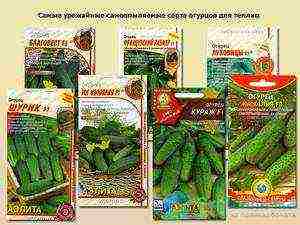 Pollinated by insects. Pollination occurs with the help of bees or other insects. Grow well outdoors. One plant contains both male and female flowers, respectively, each growing female and male fruits. They differ in the number of chambers inside the fetus. The seeds harvested for the future harvest are suitable for sowing only after two or three years. Bee-pollinated cucumber varieties are naturally pollinated. This determines the conditions for their growth and development in greenhouses. Bee-pollinated cucumbers in a greenhouse have advantages in quality of taste, rapidity of development, abundance of fruiting. They tolerate temperature changes well. A notable harvest can be obtained only on condition of high-quality pollination.
Pollinated by insects. Pollination occurs with the help of bees or other insects. Grow well outdoors. One plant contains both male and female flowers, respectively, each growing female and male fruits. They differ in the number of chambers inside the fetus. The seeds harvested for the future harvest are suitable for sowing only after two or three years. Bee-pollinated cucumber varieties are naturally pollinated. This determines the conditions for their growth and development in greenhouses. Bee-pollinated cucumbers in a greenhouse have advantages in quality of taste, rapidity of development, abundance of fruiting. They tolerate temperature changes well. A notable harvest can be obtained only on condition of high-quality pollination.- Self-pollinated cucumber varieties can be grown both in a greenhouse and in the open field. Such species contain seeds inside the fruit, and the flower of the plant has male and female reproductive organs. Thanks to their presence, the fruits are smooth. These cucumbers can be used to harvest homemade seeds for the next harvest. But remember that the quality and quantity of cucumbers will not satisfy you. All the declared properties of the species will not be fully manifested. If the variety is pollinated by insects, the fruit will be crooked. The taste of the fruit does not change from this. Self-pollinated species are available for purchase by the number of seeds and by price, and have good germination. These species are good for growing in unusual weather conditions. There is a constant improvement of existing varieties and the development of new plant species. Self-pollinated species are not capricious.
- Parthenocopic species that set fruit without pollination and contain seeds inside the fruit without embryo.
Pollination of cucumbers in the greenhouse
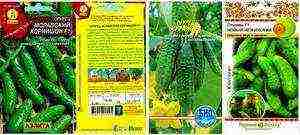 May be supported by bees or naturally. If the weather is favorable for airing the greenhouse, open windows and doors and attract insects and bees to work with plants. This method cannot guarantee high-quality pollination.
May be supported by bees or naturally. If the weather is favorable for airing the greenhouse, open windows and doors and attract insects and bees to work with plants. This method cannot guarantee high-quality pollination.
The natural process is very time consuming. The plant has two kinds of colors: male and female (monoecious plant). Task: to transfer pollen from a male flower to a female one. This should be done with a regular soft-bristled brush. You can simply pick the male flower, remove the petals, and transfer the pollen to the pistil of the female flower.
This is only possible with a large number of masculine colors. If there are enough of them, and the female flowers have not formed, then the plant will be a barren flower. The development of barren flowers depends on the seed, growing conditions, high-quality feeding and competent formation of the bush. When buying planting material in a store, choose seeds from trusted firms. Seeds harvested on their own will not yield a good harvest. In industrial greenhouses, when growing bee-pollinated varieties, hives with bees are placed.
See also: Varieties of cucumbers for the greenhouse: planting and care
Self-pollinated cucumber varieties presented by structure uses: for preparing salads, for processing for long-term storage and varieties covering all uses. Every year, new and improved varieties of self-pollinated cucumbers appear, with special characteristics and improved virtues.The terms of development are reduced, the amount of crop production increases, the resistance of the plant to specific diseases improves, and many advantages appear in the fruits.
According to the timing of development, plants are divided into species. These are early maturing, in which development from germination to fruiting is up to forty days. Mid-season ones fit in a period from fifty days to fifty-five. Late ripening ripens on time from one hundred and ten days.
The best varieties of self-pollinated cucumbers are as follows:
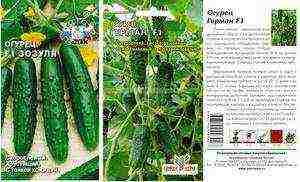 Zozulya is an early ripening high-yielding long-fruited hybrid with a ripening period of 38 days from the moment the shoots appear. The bush is not forming.
Zozulya is an early ripening high-yielding long-fruited hybrid with a ripening period of 38 days from the moment the shoots appear. The bush is not forming.- Claudia is a hybrid medium-early short-fruited variety, without bitterness. Suitable for all growing conditions and any soil. Resistant to all types of fungal diseases. The plant is highly weaving. The fruits of a friendly return, do not overripe and do not turn yellow.
- April - mid-season hybrid, long-fruited, abundant harvest.
- Spring is an early hybrid species, 37–43 days from the moment of germination to the receipt of fruits of biological ripeness. Short-fruited, with a long fruiting period. Immune to many diseases.
- Gerda is a hybrid variety of the gherkin type. Biological ripeness reaches 45-50 days after germination. Resistant to all types of powdery mildew.
- A friendly family - a hybrid variety is popular all over the world. Small dark green fruit, good for canning. Gives a high yield, resistant to many types of diseases of cucumbers.
- Cupid, Ginga - hybrids, small-fruited cucumbers, good for conservation. Biological ripeness occurs on the 50th day from the first appearance of sprouts. There is no bitterness in hereditary traits. A crunch is characteristic when eating fresh fruit.
- Moscow hothouse - an early ripening hybrid of a gherkin shape. It is very popular with summer residents, because it tolerates partial shade and short-term drought well.
- Karina F1 is a self-pollinating and modest hybrid. Grows well in covered ground and without it. Abundantly fruiting variety of gherkin type, without bitterness, universal purpose.
Parthenocarpic varieties
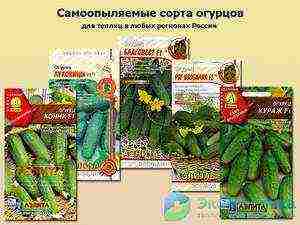 These are the plants grown by artificial influence chemical or mechanical irritant. The fruits of these varietal cucumbers do not have embryos in the seeds. Plants have significant advantages over other varieties. The lash of the cucumber has a strong branched structure. The plant itself is adapted to conditions that do not meet the necessary requirements of the manufacturer. Characterized by abundant, long and constant fruit formation. There is no genetic bitterness. Hardy species to the most important diseases of cucumbers.
These are the plants grown by artificial influence chemical or mechanical irritant. The fruits of these varietal cucumbers do not have embryos in the seeds. Plants have significant advantages over other varieties. The lash of the cucumber has a strong branched structure. The plant itself is adapted to conditions that do not meet the necessary requirements of the manufacturer. Characterized by abundant, long and constant fruit formation. There is no genetic bitterness. Hardy species to the most important diseases of cucumbers.
- Advance F1 is a newly introduced early ripening variety with improved qualities. Abundant and early recoil. Fruit ripening occurs seven weeks after germination. Short-fruited cucumber. The species is resistant to white and gray rot, downy mildew, deep systemic mycosis.
- Angel F1 is a hybrid of early maturity, universal use. A variety of gherkin varieties. No bitterness... Recommended for open and closed ground.
- Anyuta F1 - parthenocarpic hybrid of gherkin type, universal use. Branches well and pleases with an abundance of fruits. It tolerates temperature extremes, grows on all types of soil. Reliable against typical cucumber diseases.
- Blanca F1 is an ultra early parthenocarpic cultivar for open and closed cultivation. Plant of very strong growth and abundant fruiting. Fruit of the gherkin type, universal purpose. Disease resistant.
- The F1 petrel is one of the new parthenocarpic hybrids that is gaining popularity among gardeners due to its abundant fruiting. Unpretentious, grows well in the open field.
- Herman F1 is widely known in narrow circles and is extremely modest in terms of parthenocarpic requirements. Recommended for indoor, but grows well outdoors... Gherkin type and universal use.
- Gosha F1 - early ripening plentifully fruiting parthenocarpic hybrid. Gherkin type fruit without bitterness. The cucumber does not outgrow, does not turn yellow. Recommended for growing in difficult climatic conditions.
- Christina F1 - famous Dutch hybrid early ripening... Resistant to all known diseases of cucumbers, bears fruit abundantly. Resistant to adverse factors and climatic conditions. Grows best outdoors.
- Masha F1 - Dutch parthenocarpic, early ripening and bountiful harvest. Gherkin type, universal use. Fruit without bitterness. It grows equally well indoors and outdoors.
- Parker F1 is a popular and proven parthenocarpic variety. Early term and abundant fruiting, universal use. The crop is well kept and does not turn yellow.
There are a lot of parthenocapic varieties. The peculiarity of the Dutch species is that the seeds are prepared for soaking and planting. Choose the varieties you like according to the annotations on the package, sow several varieties at once, compare fruits and the taste of cucumbers. And you will get pleasure and joy from your harvest.
Attention, only TODAY!
Another option for articles on the topic


